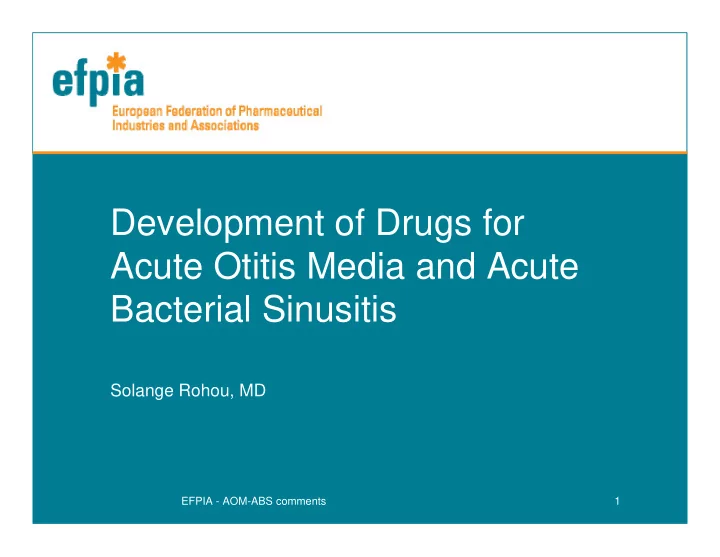

Development of Drugs for Acute Otitis Media and Acute Bacterial Sinusitis Solange Rohou, MD EFPIA - AOM-ABS comments 1
AOM and ABS: Key Issues • Are placebo-controlled superiority studies appropriate or feasible if the etiology is highly likely to be bacterial? • Can an active-control superiority study deliver when a new compound is compared to a well- dosed -lactam? – Is it ethical to enrich for isolates resistant to the comparator agent? • Are there other approaches to consider? EFPIA - AOM-ABS comments 2
Are placebo-controlled superiority studies appropriate or feasible? A focus on AOM • A serious disease, but we lack key data – AOM can have serious consequences: Mastoiditis and suppurative intracranial events* – But, only when bacteria are the causative agents – And, mild cases often show spontaneous resolution • The historical data are of poor quality – EMA guidance: “Antibacterial agents have not consistently demonstrated superiority vs. placebo in well-conducted randomised studies.” – EFPIA agrees • But, there are now new data EFPIA - AOM-ABS comments 3 *Klein 2011 NEJM 364:168-9
AOM is a treatable disease • Amoxicillin-clavulanate vs. placebo – Two independent studies*, ~150/arm in each study – High quality diagnosis: Fluid, inflammation, symptoms • Tähtinen: Amox-clav therapy reduced failure rate – 30/161 children (18.6%) vs. 71/158 children (44.9%) – 95% CI: 16-36%, Hazard ratio 0.38 (95% CI: 0.25-0.59) • Hoberman: Reduced clinical failure at or before – Day 4–5 visit (4 vs. 23%; 95% CI:12-27, P<0.001) – Day 10–12 visit (16 vs. 51%; 95% CI: 25-45; P<0.001) • Adverse events – Diarrhea more common with antibiotics – Mastoiditis in a placebo-treated child EFPIA - AOM-ABS comments * Tähtinen et al. NEJM 364:116-26, 2011; 4 Hoberman et al. NEJM 364:105-15, 2011
AOM: Equipoise is now gone • The endpoints in these studies – Were composite and need further analysis – But, all sub-components are consistent with overall effect • With these data – Equipoise before was limited: 207/498 eligible patients declined enrollment in the Hoberman trial – Equipoise is now gone: Accompanying editorial (Klein 2011): “Is acute otitis media a treatable disease? Yes.” • Future studies will require an active comparator – Lower bound of effect size certainly > 10% – High-quality data that do not require further discounting – Margin can be selected based on clinical reasoning EFPIA - AOM-ABS comments 5
AOM: Superiority designs? • EMA draft guidance: – Demonstration of superiority … based on clinical cure rates is unlikely to be feasible – … it may be appropriate that the demonstration of superiority is based on alternative relevant variables (e.g., time to specific clinical response) • We think superiority is unlikely via either path – We will use a well-recognized, relevant, approved comparator regimen – We cannot enroll if resistance to the comparator is either likely or known – Little reason to anticipate superiority in this setting vs. a properly dosed beta-lactam EFPIA - AOM-ABS comments 6
AOM: Other designs? • Delayed (rescue) therapy – Lack of equipoise makes this very difficult • Add-on therapy – This has the problems of a superiority design • Consequences – Development for this indication is unlikely until feasible active-control non-inferiority designs are agreed – As this is a key gateway indication for oral-only RTI drugs, loss of the ability to gain initial market access may reduce investment in the area – As resistance emerges, there will be no new agents EFPIA - AOM-ABS comments 7
ABS: Parallel issues, less data • ABS: Do we still have equipoise? – As for AOM, existing data are poor quality* – But, suppurative complication risk is similar to AOM – Bacteria in a closed space are always worrisome • All other issues parallel those for AOM – Superiority design, etc. • Consequences – Development for this indication is unlikely at present *Cochrane database systematic review. EFPIA - AOM-ABS comments 8 2009, issue 3
Conclusions • Antibiotic stewardship and vaccines may slow rate of emergence of resistance – But, new drugs will be needed, must anticipate need now • Active-controlled studies appear to be required – Equipoise is gone for AOM – Equipoise probably limited for ABS • Non-inferiority design appears possible for AOM – Need to work through the statistics • Resolving these issues is important – These are key gateway indications for oral-only RTI drugs – Emerging resistance is likely and new agents will be needed EFPIA - AOM-ABS comments 9
Recommend
More recommend